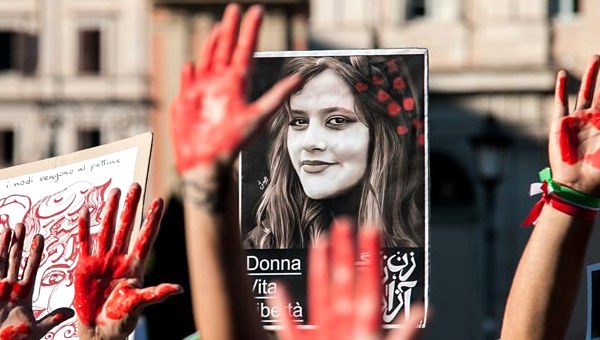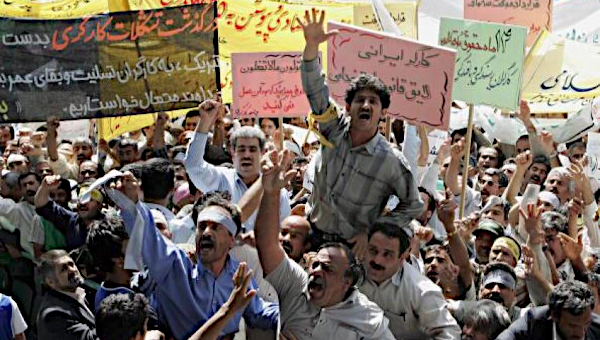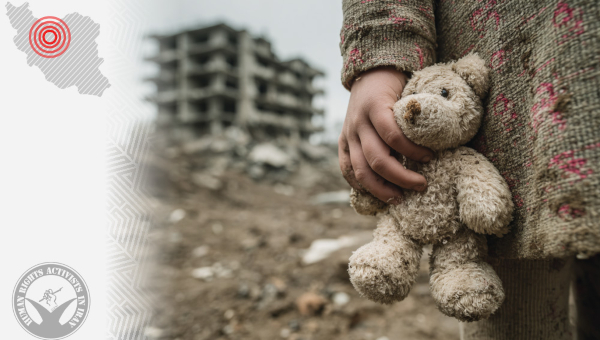Iran: A Post-Islamist Society Revolts Against an Islamist State
Zan, Zendegi, Azadi (Women, Life, Freedom) is the motto of Iran’s most recent democratic social movement, which sparked after the death in detention of Zhina Mahsa Amini by so-called Iran’s morality police on 16 September 2022. This nationwide progressive movement, largely led by women and other Iran’s subalterns, has shaken the ideological foundation of the Islamic Republic of Iran – the discourse and the institution of the velayat-e faqih (guardianship of the jurist) – and the entirety of the current Islamist state in Iran.
The Zan, Zendegi, Azadi movement has revealed that the ruling Islamist emperor has no clothes! From the early days of post-revolutionary Iran under ayatollah Khomeini’s leadership, the ruling Islamists were challenged by some sections of the society, including women’s protests on International Women’s Day in March 1979. For some intellectuals, women, and civil rights activists, the vali-ye faqih had no clothes of divinity and God’s political proxy. In the post-Khomeini era in the 1990s and 2000s, more sections of the society grasped how naked is the Islamist emperor.
Three turning points challenged the idea of reforming the state through electoral politics, revealing that elections under the velayat-e faqih had little to no meaningful impact on the life of ordinary people: The first was the crisis of reforming the political system under President Mohammad Khatami (1997-2005); the second was the suppression of Iran’s pro-democracy Green Movement in 2009 in response to the rigged presidential elections; and the third was the failure of reform under President Hassan Rouhani (2013-2021) followed by the 2021 presidential elections, which brought to power the hardliner Ebrahim Raisi. With the mass disqualification of even loyal candidates to the system, the 2021 presidential elections broke the records of the lowest turnout in postrevolutionary Iran’s elections and the highest share of protest blank and invalided votes.

The Islamist Emperor – Has No Clothes
Hence, the Islamist emperor is now naked to the majority of the people. It has become clear that this clerical oligarchy, backed by the security-military apparatus, is an institutionalized patriarchal autocracy in the name of God, but in the service of a crony clerical kleptocracy. It is a “predatory state” (Vahabi 2020) in the name of the poor, in which the public institutions are subverted to serve the ruling oligarchs. This is clearly shown in one of the many slogans of university students in Tehran in early October 2022: “Poverty, Corruption, and Injustice; Shame on this Autocracy.” (فقر و فساد و بیداد، ننگ بر این استبداد). The Islamic Republic, in sum, seems to have betrayed both the sacred and the secular, assaulting the dignity of values, which inspired many people in the 1979 revolution.
An institutionalized minority rule in the name of god, Iran’s ruling clerico-military oligarchy has gradually but constantly materialized its full capacity at the cost of marginalizing the majority, and corrupting the emancipatory spirit of the 1979 revolution. It no longer speaks on behalf of Iran’s subaltern oppressed (the mostaz’afin), and has systematically turned the citizen into the subaltern. Four decades after the revolution, the Islamic Republic policies seem to have produced a systemic disempowerment (esteza’af, استضعاف) by institutionalizing cultural, economic, social, and political subordination of the majority (Mahdavi 2023).
Islamic Republic of Iran: An Anachronical Phenomenon!
The Islamist state rules over a “post-Islamist” nation (Bayat 2013; Mahdavi 2011, 2020, 2023). Iran’s civil society has already entered into a post-Islamist social condition (not post-Islam as a religion and culture) where all forms of an Islamist state, including the velayat-e faqih, have lost their popular consent and mobilization capacity. Iran’s subaltern, the marginalized majority, has already spoken up against the ruling Islamists in numerous occasions including the 2009 Green Movement, the new waves of ongoing multiple social movements since 2017 – and particularly the 2022 Zan, Zendegi, Azadi movement – and refusing to participate in the electoral politics such as the 2020 parliamentary and the 2021 presidential elections.
The durability of the Islamic Republic depends largely, not on its discursive/intellectual power but on the clerical-security apparatuses backed by petrodollars in the rentier structure of the state. Although politically coercive, the Islamic Republic is socially and discursively fragile, frustrated, failed, and bankrupt. This is largely due to the disenchantment of Iran’s civil society with the idea and practice of Islamism, making the Islamic Republic as an anachronical phenomenon in contemporary Iran. Iran’s discursive, structural, and demographic transformations are well advanced of the patrimonial and oligarchic nature of the hegemonic political system. Iran’s post-Islamist social condition, in other words, does not project a promising future for the longevity of the ruling Islamists.
Applied in its broad sense of the concept and not necessarily referring to the former Islamists dissatisfied with Islamism, post-Islamism is a social condition of the Iranian society. Iranian society has witnessed and experienced the failure, fundamental flaws, regressive and reactionary nature of Islamism as an ideology, institution, and polity. Today’s Iran 2000s generation is a clear example of such paradigmatic and radical transformations. This generation, among other Iran’s subalterns, feel that the ruling Islamists have “colonized” their lives (Bayat 2022). The beautiful motto of Woman, Life, Freedom is a radical and clear negation of every aspect of Islamism.
The ruling Islamists, however, have survived many waves of democratic movements as they have largely relied on the suppressive institution of the deep state, comprising the Office of Velayat-e Faqih (Beyt) – sponsored by petrodollars and in charge of multi-mega revolutionary financial conglomerates (Bonyads)– and the military-security apparatuses of IRGC, as well as the rentier structure of the political economy. Moreover, the leadership, organizational and discursive disadvantages of the democratic opposition, the presence of a right-wing populist anti-intellectual chauvinism among marginal sections of the opposition, some doubt (for some social forces) about the existence of a clear road map toward a post-Islamic Republic era, and a relatively unfavorable global structure of power could contribute to the longevity of political hegemony of the ruling oligarchs. Military threats and indiscriminate economic sanctions would contribute to the securitization of public sphere, empowering the ruling oligarchs and hurting the ordinary people, who are the main agents of democratic changes from within.
Nonetheless, Iran’s magnificent discursive, structural, and demographic paradigmatic shifts at the societal level, and the fragility of the ruling coalition at the state level may contribute to a cautious optimism of a post-Islamist polity. In a post-Islamist social condition of contemporary Iran, we may follow Antonio Gramsci’s approach toward societal change and remain hopeful of overcoming the “optimism of will” over the “pessimism of intellect” (Gramsci 1971).
Zhina Mahsa Amini: An Embodiment of a “Matrix of Subjugation” under Islamism
The “Matrix of Domination”, argues Feminist scholar Patricia Hill Collins (2002), demonstrates the intersectionality of the many faces of systemic oppression, injustice, and discrimination. Such a systemic subjugation may include gender, religious-cultural, socio-economic class, ethnic-national, and territorial injustice. Inspired by her critical approach, we may argue that Zhina Mahsa Amini’s murder presents a perfect personification of how the Islamist “matrix of domination” has systematically marginalized and subjugated the majority of a nation. Being a woman, Zhina’s death represents women’s subjugation under an Islamist patriarchal ideology, gender injustice, and in some cases gender apartheid. As a Sunni Muslim living under a Shia Islamist state, her death symbolizes a religious cultural injustice experienced by Sunni Muslims and other religious minorities in Iran. Additionally, Zhina was born and raised into an Iranian Kurdish family, one among other ethnic/national minority groups in Iran who have been subject to systemic marginalization before and under the Islamist state. Also, a 22-year-old Zhina represents a generational divide/social cleavage between the old and outdated ruling Islamists and the majority youth whose “glocal” socio-cultural values and lifestyle fundamentally differs from the Islamist values. Although big in number, the youth is a subaltern group under the ruling Islamism.
Furthermore, Zhina’s small city/town of Saqez in Kurdistan’s province of Iran signifies the existing territorial injustice where core cities such as Tehran gest most of the country’s resources and budget, while the peripheries are systematically excluded and discriminated. Moreover, Zhina exemplifies the anti-hegemonic socio-cultural norms of the young generation (generations Z, Y, and more) who have resisted the hegemonic Islamist code of conduct over the decades. She truly represents a secular and “post-Islamist” generation who has been raised, educated, and indoctrinated under the Islamist state, and yet like many other groups in the society, has revolted many times against such imposed socio-cultural codes. Finally, Zhina’s socio-economic class put her in Iran’s growing subaltern class of “middle class poor” (Bayat 2017; Mahdavi 2019); this class is socio-culturally informed and educated, but economically poor and impoverished. This social class played a major role in the Arab Spring, and seems to be growing rapidly over the last two decades in Iran rose to prominence in the 2010s and 2020s uprisings. Zhina is a personification of such a large but marginalized subaltern social class victimized by Islamist neoliberal and predatory crony kleptocratic policies of the Islamic Republic.
The intersectionality of multiple injustices in today’s Iran has contributed to the synergy of many anti-status quo social forces. They radically challenge the dominant regime – not only the political but also the socio-cultural, economic regime and the whole Islamist ontology, which fundamentally negates the dignity, the livelihood, and the beauty of one word, that is Zendegi (Life). This threefold interrelated progressive motto of Women (Zan), Life (Zendegi), and Freedom (Azadi), I argue, represents a “Matrix of Emancipation”, that is a dignified life without freedom is a myth, and no single society is truly free unless its women are free and live with dignity. To follow Michael Hardt’s (2022) analogy/equation, Zan plus Zandegi equals Azadi! This is the magic of such a simple but profound, progressive, feminine, and feminist slogan of Zan, Zendegi, Azadi!
Demystifying the Myth of Middle East Exceptionalism
Like the 2009 post-Islamist Green Movement, the 2011 Arab Spring, the Gezi Park Movement of 2013 in Turkey, and several other cases of democratic social movements in the Middle East and North Africa (MENA), the movement of Zan, Zendegi, Azadi in 2022-23 is yet another prominent case to nullify, debunk and demystify the mainstream cliché and the myth of “Middle East Exceptionalism”. This idea which is ironically shared by some opposing views of Western Orientalism, nativist Islamism and even some particular interpretations of postmodern cultural relativism suggests that the Middle East and/or Muslim societies are exceptionally immune to such ideas as gender equality, democracy, pluralism, civil and human rights due to the particularity of their culture/civilization, and religion/Islam. This discourse has many shortcomings, which I have discussed elsewhere, including in The Myth of Middle East Exceptionalism: unfinished social movements (Mahdavi 2023), but it suffices to say here that such an argument, which has been revived in the post-Arab Spring, is a reductionist, essentialist, deterministic, static, monolithic and ahistorical discourse. It ignores the livelihood and dynamics of the MENA societies, reduces multiple layers of individual and social identity to a single abstract concept of religion/Islam, undermines the impact of socio-economic, political, and global structures of power, and more importantly underestimates the ongoing and everyday resistance and achievements of ordinary people in this region.
The Zan, Zendegi, Azadi Movement in today’s Iran demonstrates not only the predicament of Islamism, but also nullifies the mainstream idea that the MENA region is culturally static, patriarchal, and violent, or exclusively guided by religion. This progressive movement sparked by the killing of a woman is largely led by young women, and is manifested by its women-friendly slogan of “women, life, freedom” – a slogan originated from the Kurdish women’s struggle in Turkey in the 2000s, which has now traveled to Iran. This remarkable “glocal” phenomenon in the Middle East has inspired many including the philosopher Žižek (2022) who encounters the exceptionalist approach toward the MENA region and appreciates the global character of this movement: “It is not enough just to express sympathy or solidarity with Iranian protesters, they are not out there, far from us, part of a different exotic culture. All the babble about cultural specificities (often used by reactionary forces to justify religious and ethnic oppression) is now meaningless: we can immediately see that the Iranian struggle is the struggle of us all.”
Equally important, is how American Philosopher Michael Hardt (2022) interprets this movement. For Hardt, the fascinating slogan of Zan, Zendegi, Azadi could be a “supplement” and/or a “reinterpretation” of the French revolution slogan: “Liberty, Equality, Fraternity”. More importantly, he suggests that the word “Fraternity” implicitly reveals the patriarchal power, whereas the meaning of “Liberty/Freedom” in today’s Iran is what the French in their revolution could not have imagined, that is the inclusion of “Women” in the slogan, or a novel equation of “Women + Life = Freedom”! •
References
- Bayat, Asef. “A New Iran Has Been Born – A Global Iran.” New Lines Magazine. October 26, 2022.
- Bayat, Asef. Revolution Without Revolutionaries: Making Sense of the Arab Spring. Stanford: Stanford University Press, 2017.
- Bayat, Asef. Ed. Post-Islamism: The Changing Faces of Political Islam. New York: Oxford University Press, 2013.
- Hardt, Michael. “Michael Hardt supports Iran’s Nationwide Movement.” Zamaneh Media. October 10, 2022.
- Hill Collins, Patricia. Black Feminist Thought: Knowledge, Consciousness, and the Politics of Empowerment. New York, NY: Routledge, 2002.
- Gramsci, Antonio Gramsci. Selections from the Prison Notebooks. Eds. and Trans. Quintin Hoare and Geoffrey Nowell-Smith New York: International Publishers, 1971.
- Mahdavi, Mojtaba. “Charismatic Authority in a Hybrid State: Reading Max Webber and Beyond in Postrevolutionary Iran.” In Mehran Kamrava. Ed. Routledge Handbook of Persian Gulf Politics. London: Routledge, 2020, pp. 292- 307.
- Mahdavi, Mojtaba. “Post-Islamist Trends in Post-Revolutionary Iran.” Comparative Studies of South Asia, Africa, and the Middle East, 31:1 2011, pp. 94-109.
- Mahdavi, Mojtaba. Ed. The Myth of Middle East Exceptionalism: Unfinished Social Movements. Syracuse, NY: Syracuse University Press, 2023.
- Mahdavi, Mojtaba. “The Velayat-e Faqih: Basis, Power, and Longevity.” In Mehran Kamrava, ed. The Sacred Republic: Power and Institutions in Iran. London: Hurst, 2023.
- Mahdavi, Mojtaba. “Whither Post-Islamism: Revisiting Discourse/Movement After the Arab Spring.” In E. Mohamed and D. Fahmi. Eds. Arab Spring and the Quest for New Metaphors: Modernity, Identity and Change. New York: Palgrave Macmillan, 2019, pp. 15-38.
- Vahabi, Mehrdad. “Introduction: a symposium on the predatory state.” Public Choice (2020) 182: 233–242.
- Žižek, Slavoj. “Slavoj Žižek Sends a Message of Solidarity to the Iranians Protesting Mahsa Amini’s Murder.” Zamaneh Media. September 30, 2022.
This article first published on the In Media Res website.





